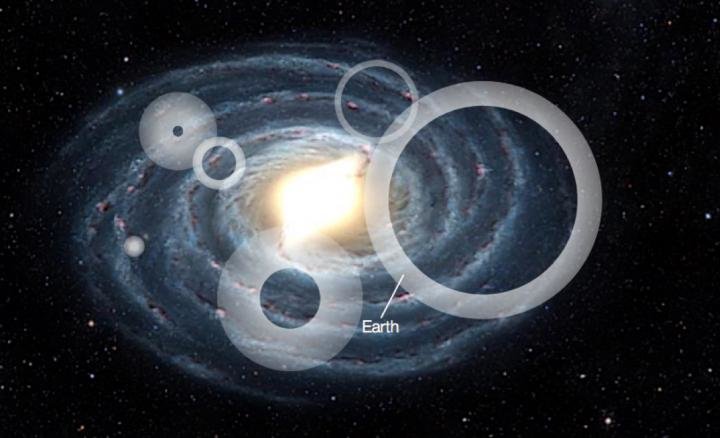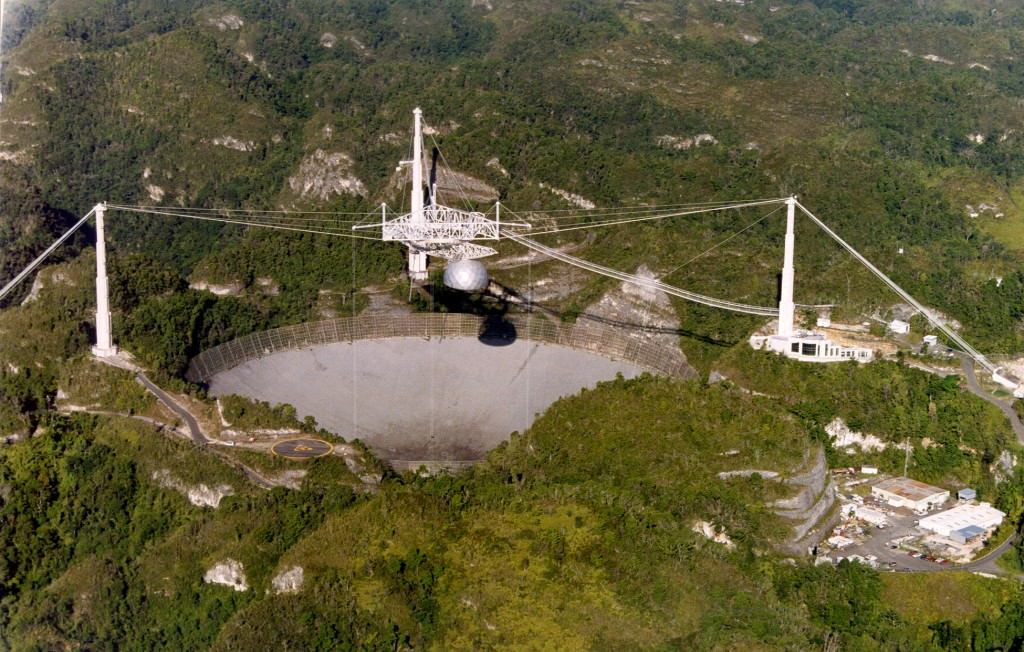Welcome back to our Fermi Paradox series, where we take a look at possible resolutions to Enrico Fermi’s famous question, “Where Is Everybody?” Today, we examine the possibility that we haven’t heard from aliens because intelligent life only survives for so long.
In 1950, Italian-American physicist Enrico Fermi sat down to lunch with some of his colleagues at the Los Alamos National Laboratory, where he had worked five years prior as part of the Manhattan Project. According to various accounts, the conversation turned to aliens and the recent spate of UFOs. Into this, Fermi issued a statement that would go down in the annals of history: “Where is everybody?“
This became the basis of the Fermi Paradox, which refers to the disparity between high probability estimates for the existence of extraterrestrial intelligence (ETI) and the apparent lack of evidence. Since Fermi’s time, there have been several proposed resolutions to his question, which include the possibility that civilizations only have a “Brief Window” with which to communicate with the cosmos before going extinct.
In general, proposals that fall under this heading acknowledge that while the Universe may actually be teeming with life, time and space impose significant limitations that make it very difficult for intelligent species to communicate with each other. In short, the distance between civilizations could mean that by the time a civilization has advanced to the point that it can broadcast a signal to space, it will be extinct before it can get a reply.

The Drake Equation
In 1961, famed SETI research Frank Drake proposed the equation that would come to bear his name during a conference at the Greenbank Observatory. Rather than being an official estimate on the number of ETIs in our galaxy at any given time, the Drake Equation was a probabilistic argument meant to summarize the challenges of SETI research. Mathematically, it went like this:
N = R* x fp x ne x fl x fi x fc x L
- N is the number of civilizations in our galaxy that we might able to communicate with
- R* is the average rate of star formation in our galaxy
- fp is the fraction of those stars which have planets
- ne is the number of planets that can actually support life
- fl is the number of planets that will develop life
- fi is the number of planets that will develop intelligent life
- fc is the number civilizations that would develop transmission technologies, and
- L is the length of time that these civilizations would have to transmit their signals into space
For the sake of the Brief Window Hypothesis, the key parameter is L. In this case, it can be defined as the amount of time a civilization can be expected to exist before succumbing to an extinction-level event. This could take the form of a natural disaster (an asteroid impact) or come in the form of self-destruction (nuclear or biological war). Using humanity as an example, these existential threats all appear as likely possibilities.
Whereas in the classical Drake Equation, L is defined as the length of time a civilization has to develop the necessary technology (ex. radio communications) and transmit a signal, the Brief Window hypothesis also considers the time it would take to get a reply. How long can a modern civilization expect to exist before a cataclysmic fate will claim it? Could this be the reason for the “Great Silence”?
Enter the Great Filter
In 1996, Robin Hanson – a philosopher a research associate at Oxford University’s Future of Humanity Institute (FHI) – published an essay titled “The Great Filter – Are We Almost Past It?” Here, Hanson proposed that there must be something in our Universe that prevents inorganic matter from coming together to create simple life and eventually giving rise to intelligent species.
This “filter,” Hanson argued, must lie somewhere between the point where life emerges on a planet (abiogenesis) and the point where it can become an interplanetary or interstellar civilization. Based on how life emerged on Earth and evolved over the course of billions of years, Hanson created a nine-step timeline . These included:
- Habitable star system (organics and habitable planets)
- Reproductive molecules (e.g. RNA)
- Prokaryotic single-cell life
- Eukaryotic single-cell life
- Sexual reproduction
- Multi-cell life
- Animals capable of using tools
- Industrial civilization
- Wide-scale colonization
In accordance with Hanson’s hypothesis, at least one of these steps must be statistically unlikely. Either life has a difficult time emerging from inorganic materials early on, or the odds of catastrophic failure increase as a species becomes more and more advanced. For the purposes of the Brief Window Hypothesis, this filter is presumed to exist between step 8 and 9, reflecting humanity’s current level of development.

Origin
One of the earliest examples of this hypothesis comes from German astrophysicist and radio astronomer Sebastian von Hoerner, a colleague of Frank Drake’s who participated in Project Ozma – the first SETI project ever mounted. In 1961, he penned a paper titled,”The Search for Signals from Other Civilizations,” where he argued that the distance between civilizations might account for why we haven’t heard from any.
To summarize, he claimed that the existential window of a technologically-advanced civilization (L) might be too short relative to the time it would take to make contact with another intelligent species. As he wrote:
“We should not underestimate the power of two critical factors that can terminate the life of a civilization once the technical state has been reached. Science and technology have been brought forward (no entirely, but to a high degree) by the fight for supremacy and the desire for an easy life. Both of these driving forces tend to destroy if they are not controlled in time: the first one leads to total destruction and the second one leads to biological or mental degeneration. In summary, we assume that a state of mind not too different from our own will have developed at many places but will have only a limited longevity.”
For the purposes of his study, von Hoerner estimated that the average lifespan of a civilization would be 6,500 years, and that the average distance between civilizations in the Milky Way would be 1,000 light years. While these were entirely speculative, they provided a framework for making estimates of how long a civilization could concievably live and communicate.
Considering when von Hoerner wrote the study – during the height of the Cold War when nuclear annihilation was a constant threat – the theme of technological advancement and self-destruction was certainly plausible. However, several variations have been proposed over the years in response to growing awareness of new existential threats. For the most part, these have centered around overpopulation and environmental destruction.
Lessons from the Anthropocene
As usual, attempts to resolve the Fermi Paradox raise inherent assumptions in the paradox and the proposed solution itself. Whether it is the Hart-Tipler Conjecture (which assumes that humanity must be the only advanced civilization in the galaxy), or that civilizations will inevitably destroy themselves, there’s the shared assumption that advanced civilization would be subject to exponential growth.
In contrast, various researchers have offered scenarios where ETIs were unable to sustain this assumed pattern of growth, thus explained why none have succeeded in colonizing the entire galaxy (or even large portions of it). In 2009, Jacob D. Haqq-Misra of the Blue Marble Space Institute of Science and Seth D. Baum of the Global Catastrophic Risk Institute argued this very point in a study titled “The Sustainability Solution to the Fermi Paradox.”
Essentially, they ventured that “[t]he absence of ETI observation can be explained by the possibility that exponential or other faster-growth is not a sustainable development pattern for intelligent civilizations.” Using lessons drawn from human history, Haqq-Misra and Baum showed how exponential growth has been a common feature of human civilizations, often to their detriment.
This has culminated in what many geologists refer to as the “Anthropocene,” an epoch where humanity is the single greatest determining factor for climate change due to the impact it has on the planet. When applied to exo-civilizations, this same tendency could explain why we don’t hear from aliens. As they stated:
“The Fermi Paradox ultimately concerns the spatial expansion of civilizations, but spatial expansion is closely linked with expansion in population, environmental impact, and resource consumption. For example, migration is often driven by resource shortages, which in turn may result from large population and/or environmental degradation. Likewise, migration to uninhabited regions can lead to resource surpluses, which can in turn drive population growth. Finally, broadly expansionist policy can cause expansion in each of space, population, environmental impact, and resource consumption.
Another example comes from a 2018 book titled Light of the Stars: Alien Worlds and the Fate of the Earth, by astrophysicist Prof. Adam Frank. This work also drew on a 2018 study titled “The Anthropocene Generalized: Evolution of Exo-Civilizations and Their Planetary Feedback,” which he conducted with colleagues from the University of Rochester, the University of Washington, and the Max Planck Institute for Biogeochemistry.
In both, Frank argued that the Anthropocene could offer a resolution to the Fermi Paradox and that the fates of exo-civilizations may be linked to that of humanity. Like us, the dynamic relationship that ETIs have with their planet likely creates feedbacks within its environmental systems. Citing the Drake Equation, Frank stressed the following:
“Earth is not unique. Even if, for example, Pc were as low as 10-19,the number of technological civilizations like our own across the history of the visible Universe would still be large enough (Nc~1000) for statistically meaningful average properties of exo-civilizations to exist. These average properties include, the average lifetime of a technological civilization. We note that represents the final factor in the Drake equation and, therefore, has a long history within the debate concerning exo-civilizations. Its importance for issues of sustainability are straightforward.”
In short, the challenge of sustainability presents a possible counter-argument to a very common assumption made by researchers tackling the Fermi Paradox. Other research has focused on the possibility that the window itself might be a function of distance, and that civilizations that send out signals to the Universe are not likely to live long enough to hear a response to their signals.
This argument was made by Claudio Grimaldi and a team of scientists – including Dr. Frank Drake – in a 2018 study titled “Area Coverage of Expanding E.T. Signals in the Galaxy: SETI and Drake’s N.” In it, the team made two key assumptions about the Drake Equation: one, that ETIs emerge in our galaxy (N) at a constant rate; two, that they’ll only be able to send transmissions for a certain amount of time stop before they go extinct (L).
Long after these civilizations have died, these broadcasts will keep traveling outward at the speed of light (c). The transmissions would form an annulus (a donut-shaped wavefront) within which the radio signals would be detectable. The thickness of each annulus’ walls (measured in light-years) will correspond to how many years the civilization was able to broadcast radio signals to space before going silent.
After modelling how these radio fronts would travel, the researchers found that two cases emerged based on whether the radiation shells are (1) thinner or (2) thicker than the size of the Milky Way (~100,000 light-years in diameter). This corresponded to the assumed lifetimes of technologically-advanced civilizations (L), which could be less than or greater than the time it takes for light to cross our entire galaxy – i.e. ~100,000 years.

In the first case, each annulus wall would be smaller than the size of our galaxy and would only fill only a fraction of it, lessening the chance of a SETI detection. But depending on how often civilizations emerge, they found, these rings might fill our galaxy with signals and even overlap. In the second case, a ring would be thicker than the size of our galaxy, but detection would depend on the number of civilizations broadcasting.
In the end, Grimaldi, Drake, and their colleagues found that the number of radio signals reaching Earth would be about the same in both cases. However, assuming that civilizations live for less than ~100,000 years (L), they determined that “the transmissions arriving at Earth may come from distant civilizations long extinct, while civilizations still alive are sending signals yet to arrive.”
In other words, by the time humanity recieves a message from an advanced civilization, it would already be dead. This has direct implications for humanity, since it means that by the time an intelligent civilization hears the Arecibo Message or any other Messaging Extraterrestrial Intelligence (METI) signal, we will be long-dead.
Criticism
Naturally, the various theories that fall under this general heading can easily be criticized for the number of assumptions they make. Using humanity as a template provides a great deal of food for thought and allows for interesting theories to be made about the development of advanced ETIs. Unfortunately, none of these theories are testable or falsifiable.

Simply put, we have no idea how long an advanced civilization can be expected to live. Short of examples of civilizations that emerged and went extinct, it is impossible to create a meaningful framework. As it stands, humanity is the only advanced civilization we know of, and we don’t even know how long we will continue to exist before an existential threat – be it nuclear war, climate change, or a natural disaster – will claim us.
Another issue emerges from the idea that advanced civilizations exist beyond Earth, but its too soon for us to have heard from them. Carl Sagan and William Newman argued this point in their 1981 study, “Galactic civilizations: Population dynamics and interstellar diffusion.” However, this argument has come under fire from critics who emphasize that it contradicts the Cosmological Principle (aka. the Copernican Principle).
In response, astrophysicist and NASA researcher David Brin has emphasized that it is foolish to consider that humanity’s development has occurred at a special point in time – i.e. when our galaxy is transitioning from having very few advanced civilizations (or just one) to several. Considering the longevity of our galaxy, it is far more likely that what we are experiencing is a typical condition.
Still, as potential resolutions go, this theory has a degree of simplicity and plausibility that is consistent with Ockham’s Razor. What’s more, the idea that humanity’s current problems are typical of intelligent species satisfies the Copernican Principle. By placing the “filter” between steps 8 and 9, it indicates that life’s ability to grow exponentially and become the single-greatest factor affecting their environment constrains their longevity.

This logic also helps to bring humanity’s greatest challenge – how to live sustainably or face collapse – into sharper focus. If we hope to live long enough to hear from other civilizations, we need to make sure we’re not living on borrowed time!
We have written many interesting articles about the Fermi Paradox, the Drake Equation, and the Search for Extraterrestrial Intelligence (SETI) here at Universe Today.
Here’s Where Are All the Aliens? The Fermi Paradox, Where Are The Aliens? How The ‘Great Filter’ Could Affect Tech Advances In Space, Why Finding Alien Life Would Be Bad. The Great Filter, Where Are All The Alien Robots?, How Could We Find Aliens? The Search for Extraterrestrial Intelligence (SETI), and Fraser and John Michael Godier Debate the Fermi Paradox.
Want to calculate the number of extraterrestrial species in our galaxy? Head on over to the Alien Civilization Calculator!
And be sure to check out the rest of our Beyond Fermi’s Paradox series:
- Beyond “Fermi’s Paradox” I: A Lunchtime Conversation- Enrico Fermi and Extraterrestrial Intelligence
- Beyond “Fermi’s Paradox” II: Questioning the Hart-Tipler Conjecture
- Beyond “Fermi’s Paradox” III: What is the Great Filter?
- Beyond “Fermi’s Paradox” IV: What is the Rare Earth Hypothesis?
- Beyond “Fermi’s Paradox” V: What is the Aestivation Hypothesis?
- Beyond “Fermi’s Paradox” VI: What is the Berserker Hypothesis?
- Beyond “Fermi’s Paradox” VII: What is the Planetarium Hypothesis?
- Beyond “Fermi’s Paradox” VIII: What is the Zoo Hypothesis?
- Beyond “Fermi’s Paradox” X: What is the Firstborn Hypothesis?
- Beyond “Fermi’s Paradox” XI: What is the Transcension Hypothesis?
- Beyond “Fermi’s Paradox” XII: What is the Water Worlds Hypothesis?
- Beyond “Fermi’s Paradox” XIII: What is the “Ocean Worlds” Hypothesis?
- Beyond “Fermi’s Paradox” XIV: What is the Aurora Hypothesis?
- Beyond “Fermi’s Paradox” XV: What is the Percolation Theory Hypothesis?
- Beyond “Fermi’s Paradox” XVI: What is the “Dark Forest” Hypothesis?
- Beyond “Fermi’s Paradox” XVII: What is the “SETI-Paradox” Hypothesis?
Astronomy Cast has some interesting episodes on the subject. Here’s Episode 24: The Fermi Paradox: Where Are All the Aliens?, Episode 110: The Search for Extraterrestrial Intelligence, Episode 168: Enrico Fermi, Episode 273: Solutions to the Fermi Paradox.
Sources:
- von Hoerner, S. “The Search for Signals from Other Civilizations,” Science, Vol. 134, No. 3493 (1961)
- Newman, W. I. & Sagan, C. “Galactic Civilizations: Population Dynamics and Interstellar Diffusion” Icarus, Vo. 46, No. 3 (1981)
- Brin, G. D. “The Great Silence – the Controversy Concerning Extraterrestrial Intelligent Life,” Vol. 24, No. 3 (1983)
- Haqq-Misra, J.D. & Baum S.D. “The Sustainability Solution to the Fermi Paradox.” Journal of the British Interplanetary Society, Vol. 62, No. 2 (2009)
- Frank, A (et al.) “The Anthropocene Generalized: Evolution of Exo-Civilizations and Their Planetary Feedback.” Astrobiology, Vol. 18, No.5 (2018)
- Grimaldi, C., Drake, F. (et al.) “Area Coverage of Expanding E.T. Signals In The Galaxy: SETI and Drake’s N.” Publications of the Astronomical Society of the Pacific Vol. 130, No. 987 (2018)

